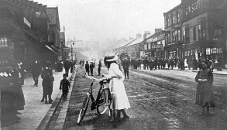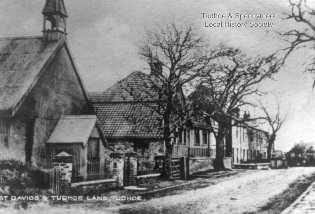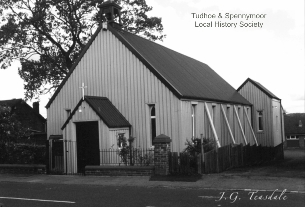
Tudhoe & Spennymoor Local History Society



The Anglican Church of Holy Innocents, serving Low Spennymoor, Tudhoe Moor, Colliery and Village, was consecrated on May 2nd, 1866 by the Bishop of Durham – the Rt. Revd Charles Baring. It was not long however before the residents of Tudhoe Colliery and Village felt the need for their own, more local Church.

It was therefore on November 7th, 1880, that the next Bishop of Durham – the Rt. Revd. Joseph Lightfoot – opened the 'Iron Church' in Tudhoe Lane as the Chapel of Ease to Holy Innocents. The corrugated iron-clad building was designed to accommodate 280 persons and had cost £620. According to a Local Directory of 1902, it was then enlarged twice – in 1882 and 1885 - increasing the capacity to 300 and the final cost to £731. Amazingly, much of the initial money had come from just one event – a Bazaar - which raised the magnificent sum of £408. 16s. 0d. – in old money! The basic structure was timber framed, clad internally with tongued and grooved boarding. The Chancel Arch is of particular note, bearing a large inscription taken from the Book of Genesis - Chapter 29, Verse 17. It was only on June 25th, 1906 however that the Church was actually dedicated to St. David in a ceremony conducted by the 62nd Bishop of Durham, the Rt Revd. Handley Moule.
The land on which St David's had been erected was not initially owned by the Church. This was rectified in February 1935, during the incumbency of the Revd Harold Woodward, when title was secured by the Vicar and Churchwardens. At the same time, the Church was expanded by a small eastern extension of the Vestry. In 1991 – 1992, a major fundraising campaign resulted in the rusting corrugated iron cladding being overlain by pressed steel sheeting, at an overall cost of £37,000. The small building which exists today therefore is perhaps surprisingly the result of three expansions and a major renovation of its exterior. Early in 2014, a further initiative was begun to replace all of its eighteen windows and make improvements to the bell tower, both elements of which are thought to date mainly from the 1880s.

Internally, changes have inevitably occurred over the years. The organ was replaced during the Spring of 1956 with one acquired from Durham Methodist Church, at an overall cost of £600. Then, during the short incumbency of the Revd Michael Pitts (1979 – 1981), the choir stalls were removed from the Chancel, the Altar was brought forward from the panelling lining the east wall and the Screen which had previously separated Nave and Chancel was re-located to form a divider between Organ and Chancel. Later, in 1985, the original pews were replaced by new pine seating made by a local craftsman.
In 1980, the Mother Church of Holy Innocents sadly closed, due to lack of finance, and was demolished in 1986. Some of the stone went to create an island folly in the newly formed lake at Whitworth Hall while two stained glass windows were recovered by Duncan MacIntosh, then Conservation Officer at Sedgefield Borough Council. The Oriel Window was given to St. David's and, since 1989, has been displayed in an illuminated cabinet attached to the panelling on the rear wall of the Nave. It was dedicated in a ceremony held on 21st May, 1989, and cost £400. It is now to be incorporated within the new East Window under the replacement programme, funded through a bequest from His Honour Judge Richard Lowden, DL, who was a former Churchwarden and Secretary to St. David's before his untimely death in 2012. The second window, which features the 'Flight into Egypt' had been in the safe keeping of Mr Macintosh since its removal. He has now donated this to St David's for insertion into one of the Side Windows. In February, 2014, the Parochial Church Council agreed that it should be set into the opening over the Children’s Activity Area, (created in 2011), as part of the window replacement programme. Thus, Holy Innocents will continue to live on, albeit greatly diminished, within the fabric of St. David's.
Since the early 1960s, St David's has had a Parish and Community Hall, sited below the Church and separated from it by a moderately sized car park. Purpose-built in brick, it comprises a main hall, stage, office, kitchen and lavatories. Between 2009 and 2013 it was extensively refurbished, at a total cost of £65,000. The hall is now busy every day of the week, sometimes up to four times a day and caters for over 12,000 users each year.
Tony Smith 2015 Tudhoe & Spennymoor Local History Society.